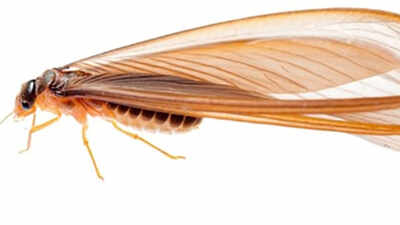Top Searches
- News
- City News
- Hyderabad News
- Eureka! Winged termites yield breakthrough nanoparticles
Eureka! Winged termites yield breakthrough nanoparticles

The shed wings of the insects were collected from OU campus, washed with distilled water to remove dust and stored at room temperature in air-tight containers.
HYDERABAD: A medical wonder was discovered from a rather unusual source__Mang Mao (winged termites) insects. Research done on the (shed) wings of the insects collected on Osmania University (OU) campus have yielded silver nanoparticles, which have anti-bacterial and anti-fungal properties. These insects get attracted to light during the monsoon.
Antioxidant and antimicrobial properties of silver nanoparticles might have applications in biomedical and agricultural sectors. The researchers, from OU and other institutes, found that the (nano) particles were also effective against bacteria like ‘Staphylococcus aureus’. So far, biosynthesis of silver nanoparticles are from plant extracts, seaweeds, micro-organisms and metabolites.
The study, ‘Silver Nanoparticles from Insect Wing Extract: Biosynthesis and Evaluation for Antioxidant and Antimicrobial Potential’, has been published in ‘Plos One’ journal recently.
Researchers Parameshwar Jakinala, Nageshwar Lingampally, Bee Hameeda from the OU department of microbiology; RZ Sayyed from Maharasthra; Yahya Khan M from Kalam Biotech, Hyderabad; Elsayed Ahmed Elsayed and Hesham El Enshasy from Egypt carried out the study to explore an eco-friendly, cost-effective and novel biomaterial for bio fabrication of silver nanoparticles.
According to the researchers, wing termites are abundant in occurrence and rich in proteins, polysaccharides and lipids. These social insects are classified into three groups — soldiers, workers and queen . After a heavy rain, the winged termites fly out in huge numbers during nights and get close to lights. The next day, they shed their wings and die due to lack of moisture. Mang Mao insects are nutrient-rich and are consumed in several Asian countries, including rural areas in India. They are also used to feed chicken, fish and birds.
The shed wings of the insects were collected from OU campus, washed with distilled water to remove dust and stored at room temperature in air-tight containers.
The researchers said: “Silver nanoparticles extracted from the insect wings exhibit strong antioxidant (around 66 to 87%) activities. These particles have antimicrobial activities with a maximum zone of inhibition against ‘Staphylococcus aureus’, the bacteria causing skin diseases and affects other body parts, and fungus ‘Fusarium oxysporum’, which causes disease in plants. Antioxidant and antimicrobial properties of silver nanoparticles may have applications in biomedical and agricultural sectors,” they said in their study.
Antioxidant and antimicrobial properties of silver nanoparticles might have applications in biomedical and agricultural sectors. The researchers, from OU and other institutes, found that the (nano) particles were also effective against bacteria like ‘Staphylococcus aureus’. So far, biosynthesis of silver nanoparticles are from plant extracts, seaweeds, micro-organisms and metabolites.
The study, ‘Silver Nanoparticles from Insect Wing Extract: Biosynthesis and Evaluation for Antioxidant and Antimicrobial Potential’, has been published in ‘Plos One’ journal recently.
Researchers Parameshwar Jakinala, Nageshwar Lingampally, Bee Hameeda from the OU department of microbiology; RZ Sayyed from Maharasthra; Yahya Khan M from Kalam Biotech, Hyderabad; Elsayed Ahmed Elsayed and Hesham El Enshasy from Egypt carried out the study to explore an eco-friendly, cost-effective and novel biomaterial for bio fabrication of silver nanoparticles.
According to the researchers, wing termites are abundant in occurrence and rich in proteins, polysaccharides and lipids. These social insects are classified into three groups — soldiers, workers and queen . After a heavy rain, the winged termites fly out in huge numbers during nights and get close to lights. The next day, they shed their wings and die due to lack of moisture. Mang Mao insects are nutrient-rich and are consumed in several Asian countries, including rural areas in India. They are also used to feed chicken, fish and birds.
The shed wings of the insects were collected from OU campus, washed with distilled water to remove dust and stored at room temperature in air-tight containers.
The researchers said: “Silver nanoparticles extracted from the insect wings exhibit strong antioxidant (around 66 to 87%) activities. These particles have antimicrobial activities with a maximum zone of inhibition against ‘Staphylococcus aureus’, the bacteria causing skin diseases and affects other body parts, and fungus ‘Fusarium oxysporum’, which causes disease in plants. Antioxidant and antimicrobial properties of silver nanoparticles may have applications in biomedical and agricultural sectors,” they said in their study.
FacebookTwitterLinkedinEMail
Start a Conversation
end of article
